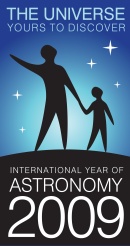
Volume XVII, Issue 41 # October 8 - October 14, 2009
|
 |
 |
 Sky Watch
Sky Watch
by J. Alex Knoll
Will the Sleeping Dragon Wake?
The Draconid meteor shower is often a snore,
but with this one you never know
Thursday and Friday evenings mark the peak of the most fickle of the annual meteor showers, the Draconids. Back in 1933 and 1946, thousands of shooting stars blazed from the constellation Draco hour after hour. Since then the dragon has slept, with most years delivering 10 to 12 meteors an hour. But every few years around October 8th and 9th, the dragon belches forth up to 100 meteors an hour.
While most meteor showers peak during the wee hours between midnight and dawn, the Draconids are most active in the early evening. Still, with this year’s waning gibbous moon rising around 9:15 Thursday and 10:15 Friday, that only leaves a few hours of ideal darkness. Look beside the North Star for Draco, and follow its the serpentine shape westward to its head. These slow-moving meteors stream forth from the dragon’s mouth, radiant or apparent source of the meteors.
At the other side of darkness, Saturn, Venus and Mercury dance together in the before-dawn. At week’s end, the three appear around 6am in the east one after the other, with less than five degrees separating them all. An hour later at sunrise they blink from view about 15 degrees above the horizon. As the new week dawns, the three pull apart, with Venus, the brightest of the three, giving up the lead to Saturn while fleeting Mercury has sunk toward the horizon and sunrise.
Mars rises in the northeast around midnight as Jupiter sets in the southwest. Tuesday the red planet is joined by the last-quarter moon just five degrees to the east. A little farther to the west shine the twin stars of Gemini, Castor and Pollux.
Illustration: © Copyright 1925 M.C. Escher/Cordon Art-Baarn-Holland; Graphics: © Copyright 2009 Pacific Publishers. Reprinted by permission from the Tidelog graphic almanac. Bound copies of the annual Tidelog for Chesapeake Bay are $14.95 ppd. from Pacific Publishers, Box 480, Bolinas, CA 94924. Phone 415-868-2909. Weather affects tides. This information is believed to be reliable but no guarantee of accuracy is made by Bay Weekly or Pacific Publishers. The actual layout of Tidelog differs from that used in Bay Weekly. Tidelog graphics are repositioned to reflect Bay Weekly’s distribution cycle.Tides are based on National Oceanic and Atmospheric Administration and are positioned to coincide with high and low tides of Tidelog.

